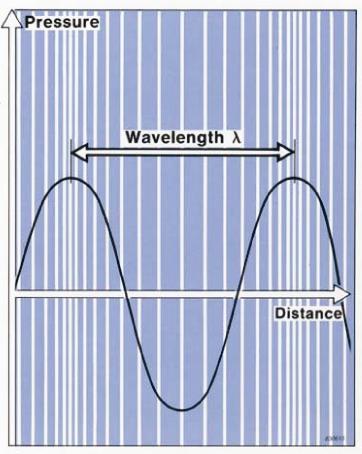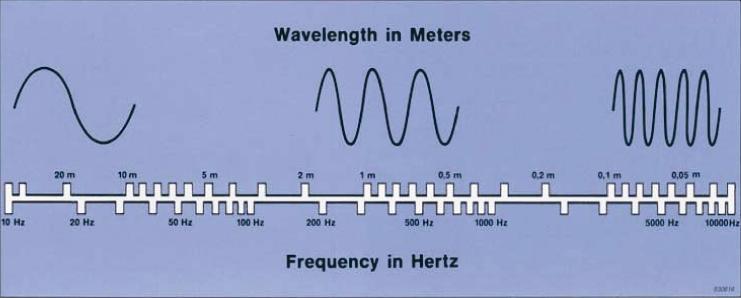Sound may be defined as any pressure variation (in air, water or other medium) that the human ear can detect. The most familiar instrument for measuring pressure variations in air is the barometer. However, the pressure variations which occur with changing weather conditions are much too slow for the human ear to detect -- and hence do not meet our definition of sound. But, if variations in atmospheric pressure occur more rapidly -- at least 20 times a second -- they can be heard and hence are called sound. (A barometer cannot respond quickly enough and therefore cannot be used to measure sound).
The number of pressure variations per second is called the frequency of the sound, and is measured in Hertz (Hz). The frequency of a sound produces it's distinctive tone. Thus, the rumble of distant thunder has a low frequency, while a whistle has a high frequency. The normal range of hearing for a healthy young person extends from approximately 20 Hz up to 20 000 Hz (or 20 kHz) while the range from the lowest to highest note of a piano is 27,5 Hz to 4186 Hz.
These pressure variations travel through any elastic medium (such as air) from the source of the sound to the listener's ears. You probably already have some idea of the speed of sound from the familiar rule for determining how far away a thunder storm is: count 3 seconds per kilometer or 5 seconds per mile from the time you see the lightning until you hear the thunder. This time interval corresponds to a speed of sound in air of 1238 km/hour or 770 miles per hour. For acoustic and sound measurement purposes, this speed is expressed 4 as 344 meters per second at room temperature.

Knowing the speed and frequency of a sound, we can calculate the wavelength-- that is, the distance from one wave top or pressure peak to the next.
Wavelength = Speed of sound
Frequency
From this equation we can work out the wavelength at different frequencies. For example at 20 Hz one wavelength is just over 17 meters, while at 20 kHz, it is only 1,7cm. Thus, we see high frequency sounds have short wavelengths and low frequency sounds have long wavelengths.
A sound which has only one frequency is known as a pure tone. In practice pure tones are seldom encountered and most sounds are made up of different frequencies. Even a single note on a piano has a complex waveform. Most industrial noise consists of a wide mixture of frequencies known as broad band noise. If the noise has frequencies evenly distributed throughout the audible range it is known as white noise and it sounds rather like rushing water. (from Bruel & Kjar)



